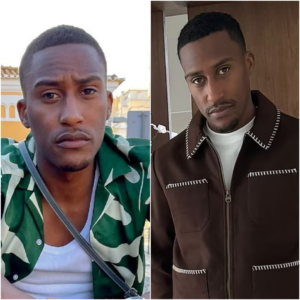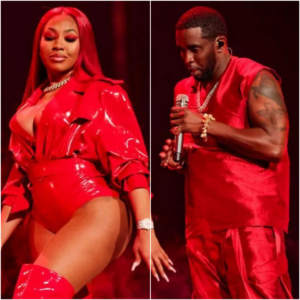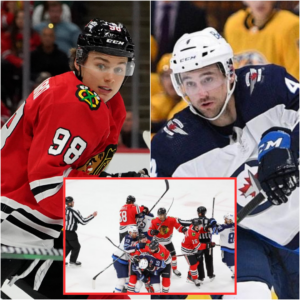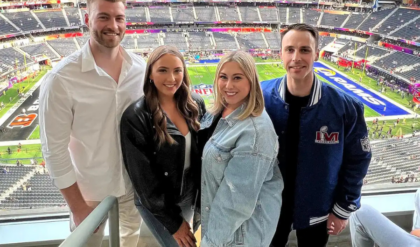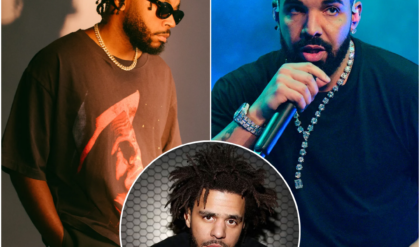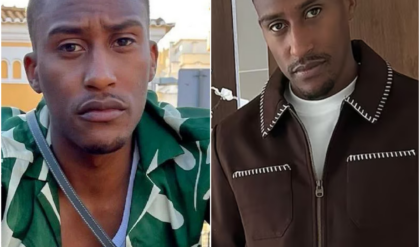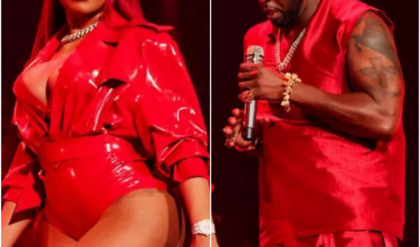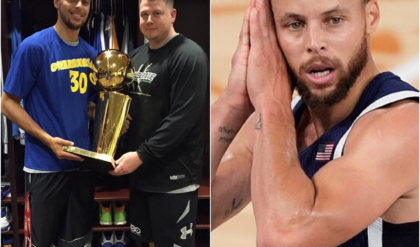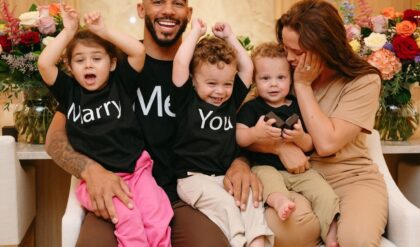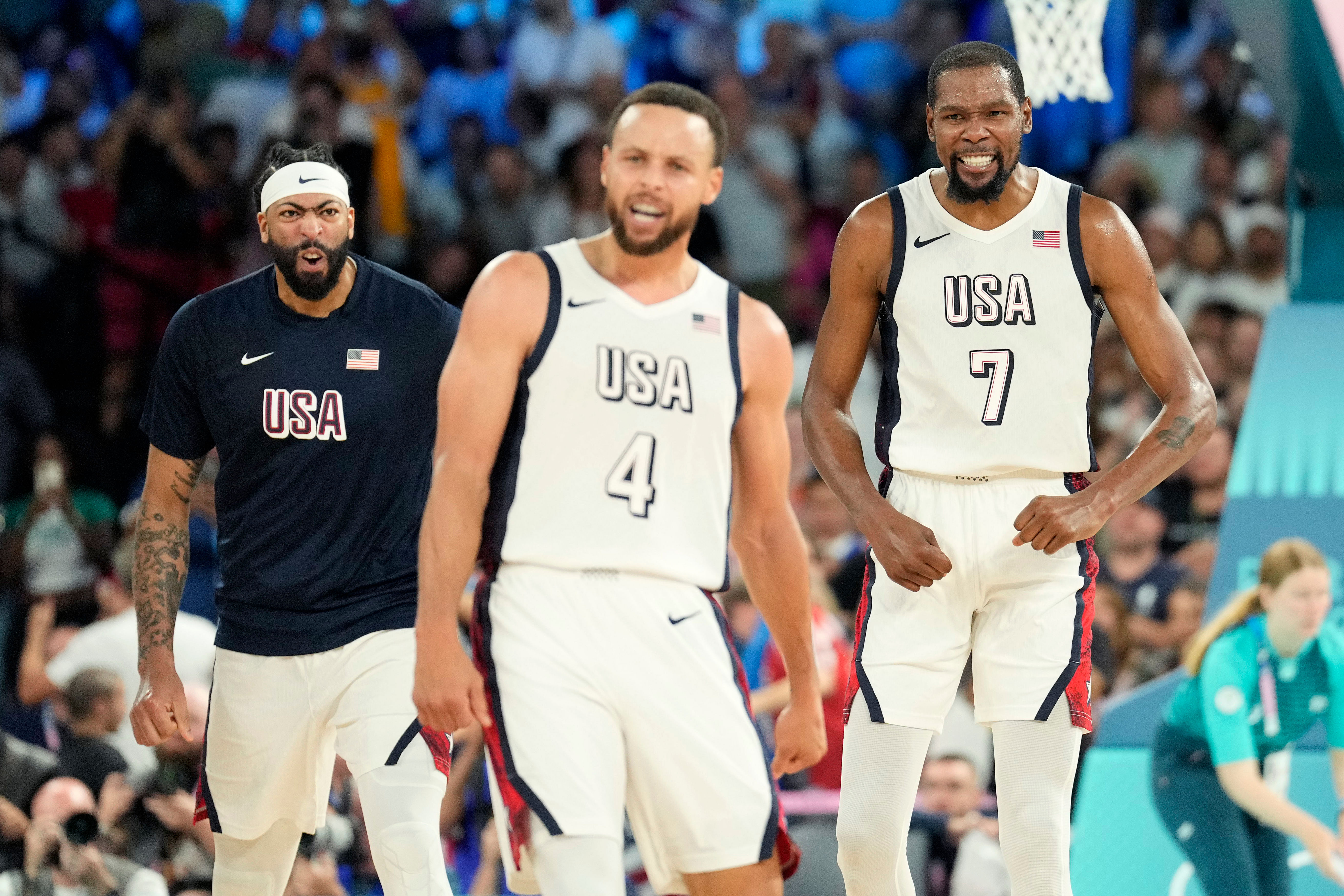 Stephen Curry @ Olympics: Basketball-Men Semifinal – USA-SRB – Source: Imagn
Stephen Curry @ Olympics: Basketball-Men Semifinal – USA-SRB – Source: Imagn
The image showcased the star power that the U.S. Men’s Olympic basketball team boasted. It also conveyed that Stephen Curry feels most confident when he shoots, even against a double team and even when other accomplished teammates are wide open.
The backstory: Curry made a dagger 3-pointer to clinch Team USA’s gold-medal win over France in the Paris Olympics over Nicolas Batum and Nando de Colo. Instead of passing to a wide-open Kevin Durant or LeBron James, Curry dribbled right, jumped back and hoisted his right leg up. That prompted Curry to run back the court while performing his “night night” gesture.
Even before the shot went in, Curry’s personal trainer maintained strong confidence that his client would make it. The reasons go beyond Curry’s track record. Brandon Payne, Curry’s personal trainer, observed that Curry placed feet and hip directly toward the rim, a balanced movement the two focus on during off-season workouts.
Explore the NBA Draft 2024 with our free NBA Mock Draft Simulator & be the GM of your favorite NBA team.
“Believe it or not, we do work on those rotational shots and going side-to-side,” Payne told Sportskeeda. “We don’t work those out to that depth, and we certainly don’t work out with that much length working against him. But those are things that he’s worked on in the past.”
Payne spoke to Sportskeeda about Curry’s Olympic gold-medal run, where he ranks his dagger 3 and how he’s preparing for the 2024-25 NBA season without Klay Thompson.
Brandon Payne on Stephen Curry’s Olympic summer
Editor’s note: The following one-on-one conversation has been condensed and edited.
How do you put Steph’s gold medal in context of all of his other accomplishments with his NBA career?
Payne: “It’s pretty high up there, especially with how it happened in the fashion that he did with the shots he hit in the final two games. I know he had an immense amount of joy playing in that setting and being on that stage. The game is always more fun when you’re playing for championships. That’s what he was doing there. To those that are truly great, when you’re in that setting, you rise to the occasion and you deliver. He was able to do that.
How do you rank the degree of difficulty of Steph’s dagger 3 against France in the gold medal game compared to his other difficult shots?
Payne: (laughs). “You’re talking about the one where he was falling away and twisting to the right?”
Yeah, and meanwhile Durant and LeBron are wide open.
Payne: “That’s pretty high up there. It’s right up there with the OKC shot [in 2016]. The moment again really elevates the shot even further. The degree of difficulty on that one is pretty high.”
You said in another interview that Steph’s explanation to you was, ‘’I was too tired to do anything else…’
Payne: “Yeah, he was getting a little tired (laughs). He took a shot, and he was hot. Any time he sees a big rim like that, there is really no bad shot for him. I was really happy for him. I’m really glad he got a chance to experience that before his career was finished.”
What was it like to hear from Steph directly right afterwards?
Payne: “Unexpected, really. I wasn’t expecting that. But it was very gratifying and special for me. We’ve been together since 2011. That’s a long time. We’ve had a lot of milestones along the way. I think when those things start happening and they happen multiple times, maybe you don’t appreciate them as much as you do. Maybe you do a little later in the journey. Through the journey, we’ve learned to really live in the moment and cherish the good things when they happen. At least for me personally. I think when he was going through that six-year Finals run and winning back-to-back MVPs, I got fooled into thinking this is the way it’s going to be for now on. Maybe we didn’t live in the moment and cherish it as much as we should have. We learned our lesson from that. I think now we can really take the time to appreciate the greatness of the moment and what’s happening.”
How did you see Steph put those things in perspective?
Payne: “I think for him, it’s a little bit different. He’s still in the middle of it. He’s still competing for championships. He’s still on a team that is capable of being very good and competing at the highest level. For him, maybe he can’t take the same steps that us that are on the sidelines can. He’s still in the middle of it. But I think with the Olympic gold medal, there was a little bit more of an acknowledgement that this is a pretty big deal and that he’s very proud of the accomplishment as he should be.”
“I’ll tell you this. The first workout we had when he got back from the Olympics, I never had seen him so excited to show me something. He came to the workout and left the gold medal at home. Steph sent our strength and conditioning coach, Carl Bergstrom, back to the house to go get the gold medal and show it to all of us so we all could take pictures with it. It was so cool to see him so excited. I think that process of winning, not that he needed to be invigorated. But I think that was a shot in the arm and a reminder that this is still a lot of fun. I’m enjoying my time. I’m enjoying the success. I’m enjoying the moment. It was so funny. He was like a kid on Christmas Day that wanted to show you something. That was really cool for me to see how happy and excited he was about it.”
Very cool. Regarding the shot, clearly the shot went in and Steph explained his thought process. But given your shooting expertise and knowing Steph, what was your internal play-by-play when you saw it unfold?
Payne: “Believe it or not, we do work on those rotational shots and going side-to-side. We don’t work those out to that depth, and we certainly don’t work out with that much length working against him. But those are things that he’s worked on in the past. I’m not saying we’ve worked on it a ton. But we’ve worked on it enough where we do have a mechanical discussion on how we shoot twisting shots, especially going to the right.”
“It’s funny. When he released it, I saw exactly where his foot and his shoulder are pointed. Those are the two markers in terms of whether it’s going to go straight or whether it’s going to pull left. When he released it, his foot and hip were right down the middle of the rim. I thought, ‘This one is great!’ (laughs). But at that point, once he sees a couple go in the way the other ones went in, anything can go in. But he was mechanically correct on that shot in terms of the way we talk about it. That was nice.”
It’s wild. I know Steph is Steph. But how do you process that he probably is the lone person to have a case to take that shot in the way he shot it when you have LeBron and KD wide open in a high-stakes game?
Payne: “Until I got back and saw a still picture of KD and LeBron with their hands up (laughs), then it kind of hit me then. I was like, ‘Those are two of the greatest players ever to play this game standing over on the side with nobody guarding him. And yet it still was a good shot (laughs).’ When you think about it in those terms, it starts to really frame just how great he is from a historical perspective. We don’t talk about it a lot. I think about it some. I think about it, especially in situations like this when it gets brought up.
“I was at an NBA practice the other day where their coach came over to me and said that Steph is one of the greatest ever to do this and to enjoy the ride. I said, ‘I’m trying really hard!’ He is really high up there from a historical perspective. He still has time left to climb even more.”
You’ve seen this play out before with Steph’s shots not falling in as normal and then Steph becoming Steph. What was the process for him with the Olympics with finding his fit on the team and getting himself going before having his strong shooting performances in the semifinals and gold-medal game?
Payne: “It’s an oxymoron. But I’ve always used this term that he’s ‘patiently aggressive.’ He displays a great amount of patience. He’s aggressively trying to get his teammates involved. He’s aggressively trying to make the right play. In basketball, you will find that if you make the right play more often than not, scoring for yourself becomes a lot easier. There were a lot of plays throughout the Olympics where he could’ve taken a shot and he probably would’ve made it. But he made a point of getting other people involved. He made a point to make sure that everybody felt like they were a big part of it because everybody is a big part of it.”
“It takes five players on the court to score. It takes five players on the court to get a big stop. It takes 10-12 players on a team to win a game. There was one play that stood out to me when Stephen got a steal. There was no one between Steph and the basket. Jayson Tatum was about even with Steph. Instead of Steph taking it in, he saw that he needed to get Jayson Tatum going. You saw him give that up to Jayson Tatum to get some rhythm with him. To me, that play really spoke volumes about the leader and teammate that he is. Steph still needed to get going. But he saw the need to have Jayson Tatum and have Jayson Tatum positive there to get him flowing and get him rolling. He did, and it turned out to be a really good decision. That tells me who he is.”
“He’ll be the first tell you that he didn’t shoot it really well in the first few games. But it speaks to his toughness, confidence and process that he’s able to work through those things. Then you go back to some of the off shooting nights that he’s had throughout the NBA. He’s always followed those up with some really good nights. It all goes back to process, belief and confidence and all of the things that we’ve talked about every day. It might sound cliché to a lot of people. But it’s real when you live and it produces results. It speaks to how strong his process is and how great of a pro he is. He’s a professional. Professionals are able to bounce back when things don’t go their way. He certainly displayed that in the Olympics.”
During media day, Steph shared his itinerary that following the Olympics that he focused on balancing rest and staying sharp. From your lane, what did that look like with post Olympic recovery and preparing for this upcoming NBA season?
Payne: “I’ve been around him for a long time now, and I still don’t know how he does everything that he does. It’s incredible to see him balance his family with being a father and managing the business side. That’s much larger than most people realize along with recovering, resting and getting better at the same time. Those are all delicate balances across all facets of his life. So it’s not just basketball. It’s about the other things that go into it as well.”
“Mental fatigue and physical fatigue, there is not a whole lot of differences between the two. They are both very real. To balance all of those things is another reason he is so great. He has so many responsibilities. He has so many things on his plate. And he’s always able to do with it a smile on his face and is always able to do it with a great level of detail and great level of execution. I marvel at what he’s able to do day in and day out.”
“There’s very rarely a day that we end a workout that he’s just going to go home and sit on the couch and watch TV. I don’t think those days exist. He’s always headed off to do something that he’s got to do because of his responsibilities. From that standpoint, he might be a greater balancer of his daily schedule than he is as a basketball player. That is saying something.”
How is Steph preparing for this season without Klay?
Payne: “We haven’t talked about that aspect of it a bunch. Of course, it’s going to be an adjustment when you’ve been with somebody for so long and now they’re not there. We haven’t talked about that a whole lot. You find that when you’re going through an offseason, you spend that time focusing on things that you need to do to be the best version of yourself for your teammates. I know that sounds funny. But once you get into the season, then your thoughts shift a little bit. So we didn’t talk about that a whole lot.”
“His preparation was very similar to what we’ve always done in the past. But of course we’ve modified it based on the physical load that we took on this summer. Unfortunately, we had more time this summer than we usually had because we didn’t go quite as far in the postseason as he would’ve liked. We did have additional time to prepare for the Olympics. That gave us additional time to rest on the other side of the Olympics before we really hit the ground running to get to the finish line before training camp. I feel really, really good about where he is. Carl has done a great job with getting him ready strength wise and being the best version of himself physically. I think he’s done a good job from a skills standpoint with making sure that we’re not only maintaining and sharpening what has always been there. But we also are still pushing the boundaries and trying to add new things. He’s done a great job with that.”
What are the new things?
Payne: “It’s not notable. But it is understanding that defenses around the NBA continue to evolve with the way they try to take things away. They continue to get more creative. So you have to have more creative solutions and more creative answers and different ways to score. So we just worked on some things with what would be deemed odd-angle finishes and odd-fading finishes that we think can produce some results. It’s about getting into space and fading into different directions. It’s fading using ball fakes and then creating space as you’re going into the shot. You’re not always trying to create space on the ground. We understand the league keeps getting bigger. The league keeps getting more athletic and faster. So you have to come up with some solutions.”
The new GM survey ranks Steph as the most clutch, best shooter, best leader and best at moving without the ball. But Steph isn’t ranked best point guard behind Luka [Doncic] and Shai [Gilgeous-Alexander]. What’s your perspective on this?
Payne: “It’s funny. You find that coaches and GMs around the NBA, it’s like talking to 10 different CPAs about taxes. You’re probably going to get some variance. Coaches and GMs all value things differently. So everybody has their idea for what they think the perfect point guard is or who the best point guard is. They may vote for something that they think fits with what they do better. I don’t buy a whole lot into what the majority say. It really only takes one that matters – the one that you play for (laughs).”
“For me, when you’ve been with him at this point as long as I have been and am constantly looking for anything to motivate him, I actually appreciate it. Keep voting the way you’re voting because it actually helps me out. It gives me a little bit of ammunition to help him. If we’re having a tough day, I can always pull that out. It doesn’t bother me much right now. I’m sure he’s seen it, but I don’t think it’s bothering him too much (laughs).”
To your point that Steph’s Olympic run gave perspective on his other accomplishments and a shot in the arm, how do you see that carrying over with both how strong he’s playing but also stepping into a different reality with question marks on the Warriors’ roster and potential?
Payne: “You look at it as an opportunity. It’s an opportunity to grow. Those types of things are exciting. That’s not to say anything ever got stagnant. It certainly did not. But it’s a new opportunity to grow. That can be exciting, stimulating and keep you and everyone else engaged. Obviously, it sucks. With Klay and the Warriors, everybody would’ve loved to have seen it go on the way it was. But it’s the reality of the economics in the NBA that make it very difficult.”
“I think it’s a new opportunity to grow as a leader, a basketball player and a communicator. You have new players around you, so you have to learn all of their personalities. I’m sure there will be some sort of adjustment period. But what that adjustment period looks like inside the building is going to be a lot different than how people perceive it outside the building. I think they’re probably cherishing and relishing the opportunity they have. They have an opportunity to be successful if they treat it correctly.”
“I’m excited to watch him and see him play this year. I said a few years ago in the 2020-21 season that somebody came out with stats that he was the first player over the age of 33 to do this. I said it then and will stick by it. He’ll continue to be that guy where we have to look up those statistics. He’s going to continue to be the first player at a certain age to accomplish things.”
Mark Medina is an NBA insider for Sportskeeda. Follow him on X, Instagram, Facebook and Threads.
News
Hailie Jade Scott’s Sister Alaina Marie Gushes About Being ‘Auntie’ in Sweet Post
Eminem’s daughter Hailie Jade Scott is pregnant — and one special person in her life is unable to contain her excitement about it. Hailie’s sister Alaina Marie took to Instagram recently to post a sweet message about how she can’t wait to become an aunt….
Drake reacts strongly to J. Cole’s new song about why he pulled out of the fight between Drake and Kendrick Lamar
Instagram/champagnepapi In a surprising turn of events, the Canadian rap star shows love to the Germany-born emcee and his song ‘Port Antonio’, on which he comes clean about the reason why he ducked out of the war. Drake has had a…
Yung Filly, a famous rapper, was arrested in Australia in connection with allegations of sѕєχual assault during a tour.
Instagram British YouTuber and rapper Yung Filly, whose real name is Andres Felipe Valencia Barrientos, has been charged with multiple serious ѕєχual assault offenses while on his Australian tour. Andrés Felipe Valencia Barrientos, better known as Yung Filly, was recently arrested…
Diddy’s Ex Yung Miami Trolled by TikToker Asking Her to Sign Baby Oil
Watch how the ‘Rap Freaks’ raptress reacts when a man asks her to sign a bottle of baby oil after it was revealed that the feds discovered roughly 1,000 bottles of baby oil at the embattled rapper’s property. Yung Miami has…
Evander Kane’s fiancee Mara Teigen talks about having more kids and enjoying motherhood
Edmonton Oilers forward Evander Kane is out of the team’s lineup as he recovers from hernia surgery in September. But off the ice, things are going well for him and his family. On Friday, Kane’s fiancee Mara Teigen took to…
NHL fans react furiously as Connor Bedard is hit in the hip by Neal Pionk to tie the score, a worrying threat for the Blackhawks
NHL fans react to Neal Pionk’s hit on Connor Bedard in Blackhawks vs. Jets (Source: Imagn) Connor Bedard took a big hit from Neal Pionk in a game between the Chicago Blackhawks and the Winnipeg Jets on Friday. TSN shared the…
End of content
No more pages to load


